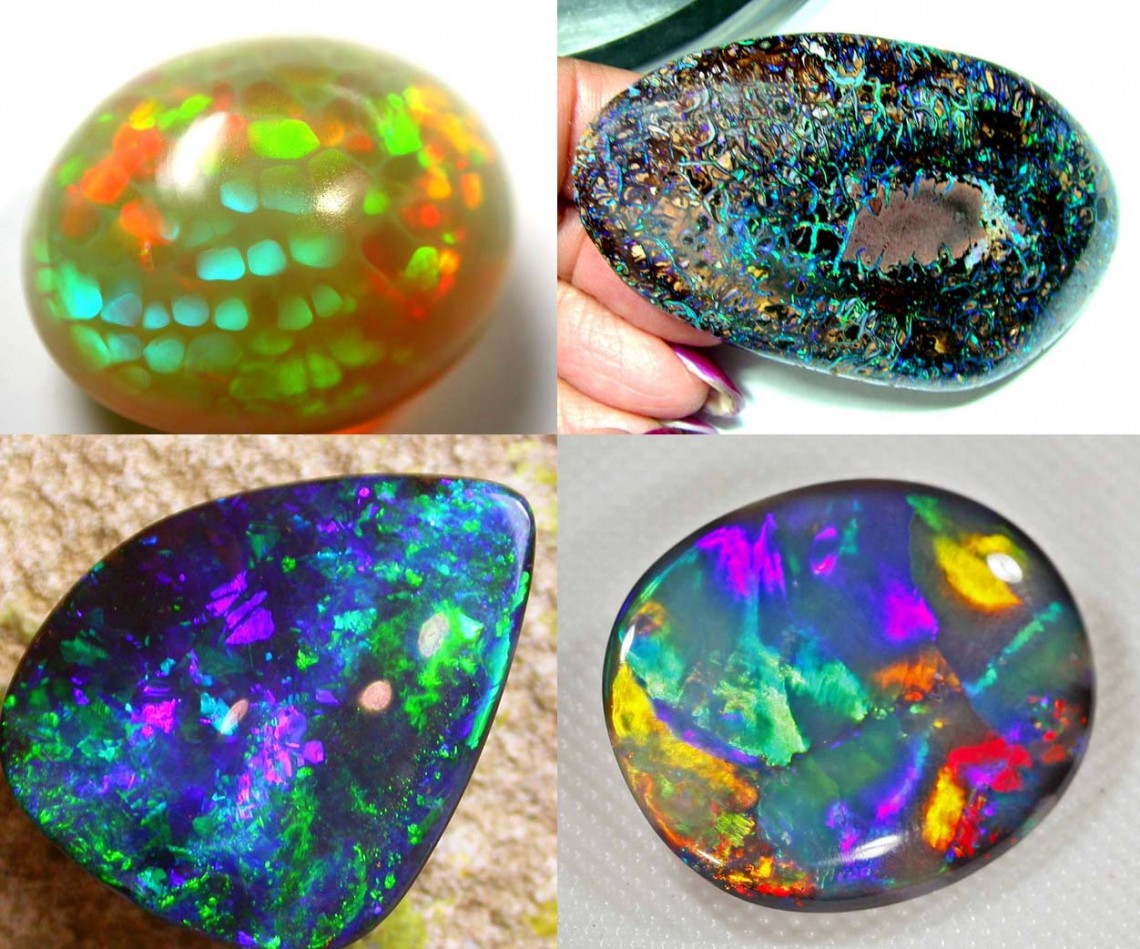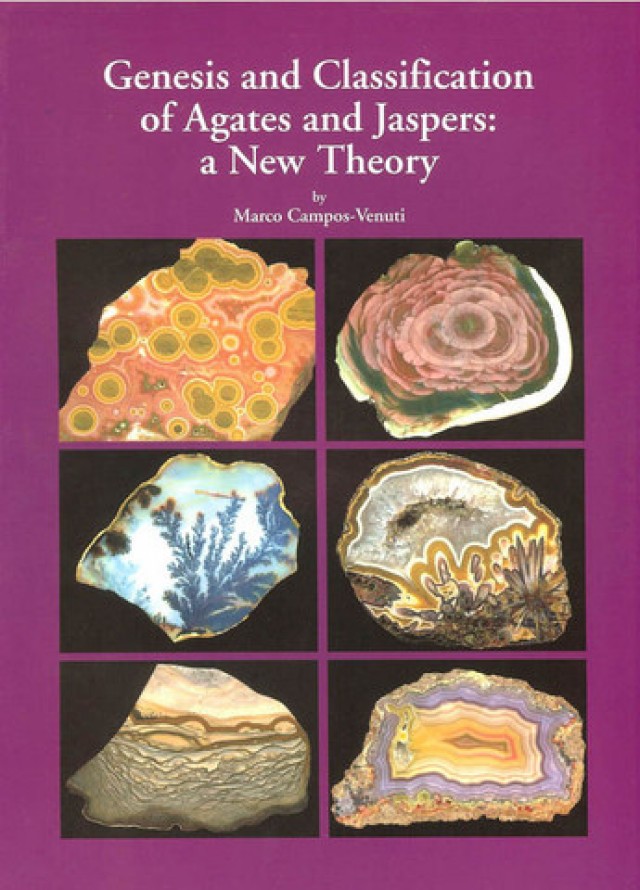
Veröffentlicht am 8th May 2018
Geändert am 17th Nov 2025
Wie entsteht Opal?
 Als ehemaliger Opalgräber tat ich diese Frage meist ab, da meine Aufgabe darin bestand, die Schönheit des Steins zu verkaufen und nicht seine chemische Zusammensetzung zu analysieren. Es herrscht noch immer keine Einigkeit darüber, wie Opal entsteht und wie alt er ist. Die gängige Theorie in Lightning Ridge besagte, dass kieselsäurehaltiges Wasser durch den Sandstein sickerte und Hohlräume und Risse füllte. Das Wasser verdunstete dann, und das Opalgel erstarrte.
Als ehemaliger Opalgräber tat ich diese Frage meist ab, da meine Aufgabe darin bestand, die Schönheit des Steins zu verkaufen und nicht seine chemische Zusammensetzung zu analysieren. Es herrscht noch immer keine Einigkeit darüber, wie Opal entsteht und wie alt er ist. Die gängige Theorie in Lightning Ridge besagte, dass kieselsäurehaltiges Wasser durch den Sandstein sickerte und Hohlräume und Risse füllte. Das Wasser verdunstete dann, und das Opalgel erstarrte.
Bei den Opalvorkommen im Virgin Valley in Nevada, USA [wo auch schwarzer Opal produziert wird] geht man jedoch davon aus, dass heißes, kieselsäurehaltiges Wasser nach oben gedrückt wurde und die Vegetation verdrängte, um Opal zu bilden.
Die Einheimischen glauben, dass der Opal im Virgin Valley etwa 50.000 Jahre alt ist, während wir seit jeher davon ausgehen, dass der Opal in Lightning Ridge in der Kreidezeit vor 100 Millionen Jahren entstanden ist. Dies belegen Funde von opalisierten Dinosaurierknochen, Pflanzen und Fischen.
Es wurde vermutet, dass es rund fünf Millionen Jahre dauerte, bis sich etwa ein Zentimeter (etwas mehr als ein Drittel Zoll) Opal bildete; möglicherweise dadurch, dass Regen das Kieselgel in den Opalstaub spülte.
Dies basierte auf der Theorie, dass die meisten der in Lightning Ridge gefundenen Fossilien aus der Kreidezeit stammen.
Mittlerweile sind jedoch viele Menschen der Ansicht, dass die fossilen Hohlräume viel später mit Opal aufgefüllt wurden, und einige vermuten sogar, dass das Gestein weniger als 100.000 Jahre alt sein könnte.

Boulder Opal
Der in Queensland gefundene Opalblock entsteht auf eine etwas andere Weise als andere australische Opalarten; er bildet sich im Inneren einer Eisenerzkonkretion. Diese Konkretion entstand durch Ionisation infolge von Sedimentablagerungen.
Die Opalminen von Spencer in Idaho, USA, bei denen die Opallösung oder Kieselsäure ein sekundäres Ablagerungsprodukt war, das durch Geysiraktivität transportiert wurde.
Durch mehrere Eruptionen über einen längeren Zeitraum hinweg lagert sich der Opal in Schichten ab. Die meisten dieser Schichten sind dünn, wodurch einige der schönsten Triplett-Opale der Welt entstehen. Der Opal lagert sich hydrothermal in hohlen Geoden in aufeinanderfolgenden Schichten ab, was den Spencer-Opal ideal für Triplett-Opale macht, da die dünnen Schichten aus extrem hochwertigem Edelopal sehr transparent sind und eine hohe Farbintensität aufweisen.
CHEMISCHE BEDINGUNGEN
Die chemischen Bedingungen der Opalbildung werden noch erforscht. Einige Wissenschaftler gehen jedoch davon aus, dass in einem bestimmten Stadium des Prozesses saure Bedingungen herrschen müssen, um Siliciumdioxidkugeln zu bilden, die möglicherweise durch Mikroorganismen entstehen. Man nimmt außerdem an, dass Aluminiumoxid, Eisen(III)-oxid oder Magnesiumoxid sowie Natriumchlorid oder Natriumsulfat benötigt werden.
Die NSW Primary Industries vermutet, dass Mikroorganismen eine Rolle spielen könnten. Zum Zeitpunkt der Ablagerung der Kreide-Sedimente boten reichlich organische Substanz und Montmorillonit (Smektit) in einigen Sedimenten einen idealen Lebensraum für die Mikroorganismen. Von ihnen ausgeschiedene Säuren und Enzyme führten zur chemischen Verwitterung von Tonmineralien und Feldspäten im umgebenden Gestein. Letztendlich schufen die kontinuierlichen Prozesse der Mikroorganismen – ihre Nahrungsaufnahme und Stoffwechselprodukte – günstige physikalische und chemische Bedingungen für die Opalbildung.
Wachsender Opal
Opal wurde in Gläsern mithilfe eines Elektrolyten (einer elektrisch geladenen chemischen Lösung) gezüchtet, wobei es Wochen dauern kann, bis erste Farben sichtbar werden. Es handelt sich dabei lediglich um ein Gel, das nicht aushärtet. Man geht davon aus, dass dieser Prozess auch in der Natur vorkommt und erklären würde, wie Opal in vulkanische Gesteine oder in den Kern eines Gesteins gelangte.
CSIRO-FORSCHUNG ZUR OPAL-FARBENTSTEHUNG
Mithilfe eines Elektronenmikroskops entdeckte Dr. Sanders, dass Opal aus Millionen winziger Siliciumdioxid-Kügelchen in regelmäßiger Anordnung besteht. Zwischen diesen Kügelchen befinden sich noch kleinere Löcher oder Zwischenräume, durch die Licht gebeugt wird. Das heißt, wenn weißes Licht oder gewöhnliches Sonnenlicht durch diese Löcher fällt, wird es in seine Spektralfarben aufgespalten. Bei Opal mit kleinen Kügelchen entstehen die dunkleren Farben des Regenbogens – Violett, Indigo und Blau. Sind die Kügelchen groß, entstehen Gelb-, Orange- und Rottöne. Edelopal findet man, wenn die Kügelchen regelmäßig angeordnet sind. Bei Potch- oder gewöhnlichem Opal gibt es kein festgelegtes Muster. Offenbar wurde Opal an verschiedenen Orten durch viele verschiedene Einflüsse geformt, wodurch Opale mit jeweils einzigartigem Charakter entstehen. Ich bin nach wie vor der Ansicht, dass dies ein Mysterium oder eine Magie der Natur ist, also genießen wir seine Schönheit.
Wie Opal entsteht – Meinungen eines Vulkanologen
Der Autor Marco Campos Venuti hat soeben ein neues Buch mit dem Titel „Entstehung und Klassifizierung von Achaten und Jaspis“ veröffentlicht. Er ist promovierter Vulkanologe und Herausgeber der „Gemmologica Italiana“. Wir danken Marco Campos für die Genehmigung zur Veröffentlichung.

Opal ist ein gehärtetes Kieselgel mit der Formel SiO₂·nH₂O, das aus einer konzentrierten Lösung abgeschieden wird. In lebenden Organismen, die organischen Opal produzieren, wie beispielsweise Kieselalgen, Strahlentierchen, Schwämmen und vielen Gefäßpflanzen, reichert sich Kieselsäure in speziellen Zellkompartimenten an, wo spezifische Proteine die Ausfällung von Opal-A bewirken.
Anorganischer Opal entsteht hingegen durch das Zusammenwirken mehrerer Faktoren. Er benötigt einen kieselsäurereichen Boden, wie er in vulkanischen Gebieten oder durch quarzreichen Sand vorkommt. Ein stark basischer pH-Wert (>9) begünstigt die Bildung von Solen mit hoher Kieselsäurekonzentration. Zudem ist Grundwasser mit starken saisonalen Schwankungen des Grundwasserspiegels erforderlich, was die Kieselsäurekonzentration erhöht. Weiterhin ist ein Katalysator notwendig, um die Kieselsäure auszufällen. Die Katalyse kann durch einen Temperaturanstieg, eine Verschiebung des pH-Werts in den sauren Bereich oder durch die Anwesenheit bestimmter Moleküle wie Eisenoxid, Aluminiumoxid, Magnesiumoxid, Natriumsulfat oder einfach Meersalz ausgelöst werden.
Wenn ein Opalvorläufer als viskoser Feststoff abgelagert wird, kann er eine Porosität von über 35 % aufweisen, die teilweise mit Wasser gefüllt ist. Trocknet die Probe, zerfällt sie und verwandelt sich unwiderruflich in ein weißes Pulver. Dies ist das Hauptproblem bei der Herstellung von synthetischem Opal. Im Labor muss diese Porosität mit einem Harz gefüllt werden, das die optischen Eigenschaften des Opals nicht verändert. In der Natur wird anderes Silicagel verwendet, welches in den meisten Fällen die Opalqualität mindert. Die Umwandlung von mineralischem Opal in Jaspis kann auch durch Diagenese erfolgen.

Lassen Sie uns einige der oben genannten Begriffe in einfachen Worten erklären.
Kieselalgen
Diatomeen sind Algen mit charakteristischen, transparenten Zellwänden aus Siliziumdioxid, das mit einer kleinen Menge Wasser hydratisiert ist (SiO2 + H2O).
Radiolarien
Es handelt sich um amöboide Protozoen, die komplexe Mineralskelette bilden.
Kieselsäure
(H4SiO4) ist ein wichtiger Nährstoff im Ozean
Salzlösungen
Sole ist eine Lösung von Salz in Wasser. In verschiedenen Kontexten kann sich Sole auf Salzlösungen beziehen.
Anorganischer Opal
Anorganische Verbindungen gelten traditionell als Produkte geologischer Prozesse. Organische Verbindungen hingegen kommen in biologischen Systemen vor.
Opale kaufen
Suche nach Opal Encyclopedia
Verwandte Auktionen
In Verbindung stehende Artikel
Opale, die rissig aussehen, können lediglich Haarrisse aufweisen. Wir werden den Unterschied zwischen den beiden Zuständen erläutern und erklären, wie ein rissiger Opal repariert werden kann.
8th May 2018
Sie dachten, Sie könnten sich keinen schwarzen Opal leisten? Nun, wir möchten Ihnen sagen, dass es für jeden Geldbeutel den passenden schwarzen Opal gibt.
15th Oct 2020
Ein Harlekin-Opal ist der seltenste Opal der Welt. Wir erklären Ihnen, welche Eigenschaften ein Stein aufweisen muss, um als echter Harlekin-Opal zu gelten, und zeigen Ihnen einige Exemplare aus unserem Verkaufsangebot.
9th May 2018
Neue Artikel
Schwarze Opale sind die begehrteste Opalart. Ihre tiefe Basis erzeugt ein regenbogenfarbenes Farbenspiel an der Oberfläche. Entdecken Sie die Verwendung, Eigenschaften, Geschichte und den Wert schwarzer Opale!
7th Dec 2025
Erfahren Sie, wie Opale bewertet werden und welche Faktoren ihren Preis beeinflussen. Von Farbe und Leuchtkraft bis hin zu Schliff und Herkunft – lernen Sie, wie die verschiedenen Opalarten bewertet werden, inklusive Preisbeispielen.
19th Jul 2023
Begeben Sie sich auf eine Reise und erfahren Sie von unserer Gastautorin Vivien Schapera von Crystal Healing Techniques mehr über die Heilkraft von Opalen!
20th May 2023
Artikelkategorien
All there is to know about Opals including Black Opals, Ethiopian Opals & Boulder Opal
14 Artikel
Check out our fascinating information and articles on all things amazing in the Opal world
41 Artikel
Opal Auctions sellers who are approved as opal Verified Sellers
4 Artikel








